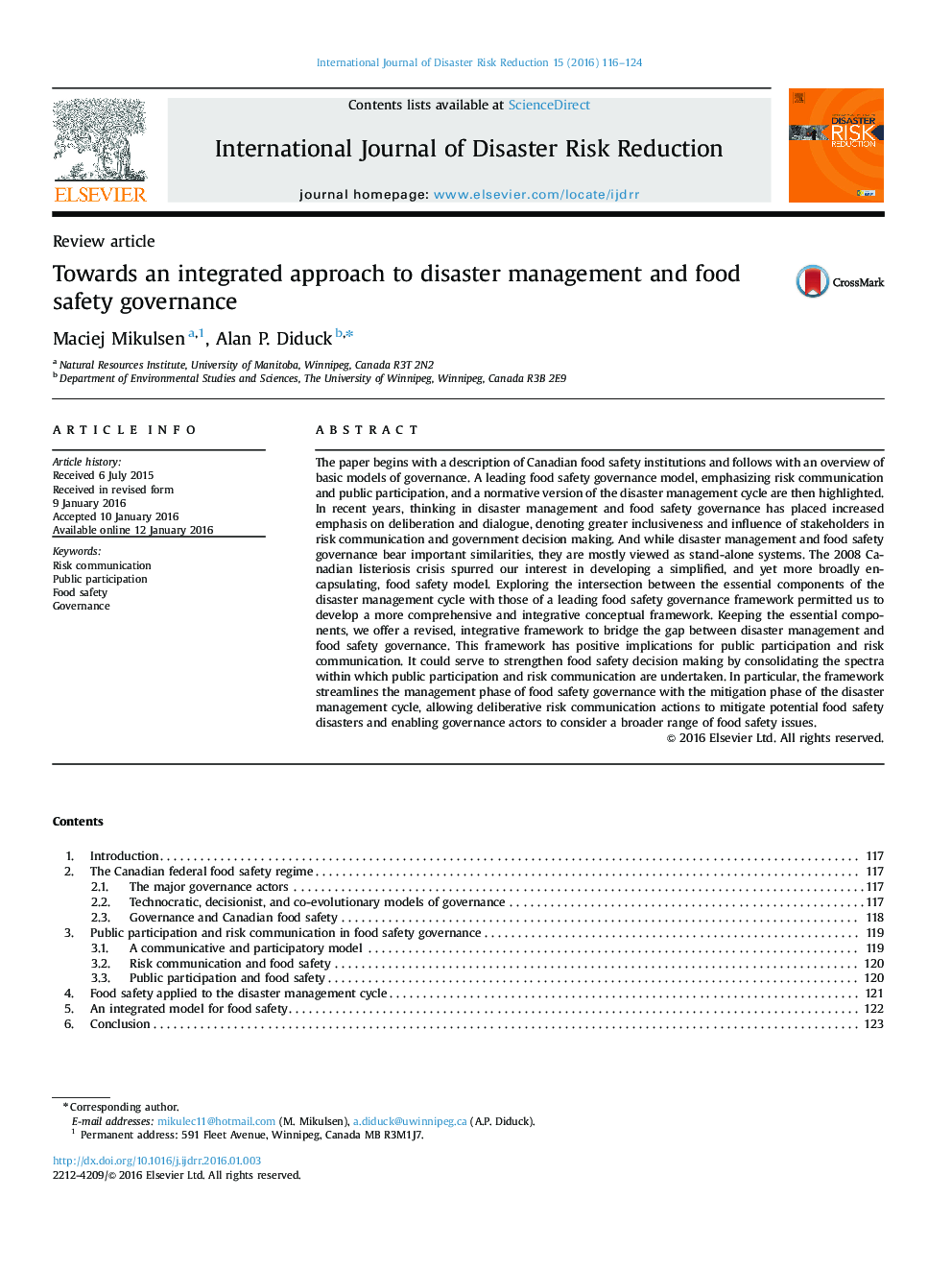| کد مقاله | کد نشریه | سال انتشار | مقاله انگلیسی | نسخه تمام متن |
|---|---|---|---|---|
| 7472811 | 1485155 | 2016 | 9 صفحه PDF | دانلود رایگان |
عنوان انگلیسی مقاله ISI
Towards an integrated approach to disaster management and food safety governance
ترجمه فارسی عنوان
به یک رویکرد یکپارچه در مدیریت بلایا و مدیریت ایمنی مواد غذایی
دانلود مقاله + سفارش ترجمه
دانلود مقاله ISI انگلیسی
رایگان برای ایرانیان
کلمات کلیدی
ارتباط ریسک، مشارکت عمومی، ایمنی مواد غذایی، حکومت،
ترجمه چکیده
این مقاله با توصیف موسسات ایمنی مواد غذایی کانادا آغاز می شود و با مرور کلی مدل های پایه ای از حکومت، همراه است. یک مدل حاکم بر ایمنی غذایی ایمنی، با تاکید بر ارتباطات ریسک و مشارکت عمومی، و یک نسخه استاندارد از چرخه مدیریت بحران، برجسته می شود. در سال های اخیر، تفکر در مدیریت فاجعه و مدیریت ایمنی مواد غذایی تأکید بیشتری بر بحث و گفتگو داشته است، که نشان دهنده جامعیت و نفوذ ذینفعان در ارتباطات ریسک و تصمیم گیری های دولتی است. و در حالی که مدیریت حوادث و مدیریت ایمنی مواد غذایی شباهت های مهمی دارند، بیشتر آنها به عنوان سیستم های مستقل مورد توجه قرار می گیرند. بحران لیزریئوزی کانادا در سال 2008 علاقه ما را به توسعه یک مدل ایمنی غذا ساده و در عین حال وسیع تر به وجود آورد. بررسی تقاطع بین اجزای ضروری چرخه مدیریت بحران با چارچوب حاکمیت ایمنی مواد غذایی اجازه می دهد که ما چارچوب مفهومی جامع تر و یکپارچه را توسعه دهیم. نگه داشتن اجزای ضروری، ما یک چارچوب اصلاح شده و یکپارچه برای پر کردن شکاف بین مدیریت بحران و مدیریت ایمنی مواد غذایی ارائه می دهیم. این چارچوب دارای پیامدهای مثبت برای مشارکت عمومی و ارتباطات خطر است. این می تواند به منظور تقویت تصمیم گیری در مورد ایمنی مواد غذایی با تحکیم طیف هایی که در آن مشارکت عمومی و ارتباطات ریسک صورت می گیرد، کمک کند. به طور خاص، این چارچوب، مرحله مدیریت فرآیند مدیریت ایمنی مواد غذایی را با مرحله کاهش ریسک چرخه مدیریت بحران بهبود می بخشد، و اقدامات ارتباطی ریسک مشورتی را برای مقابله با بلایای ایمنی احتمالی مواد غذایی و فعال کردن اعضای حاکمیت در نظر می گیرد تا دامنه وسیعی از مسائل مربوط به ایمنی مواد غذایی را در نظر بگیرد.
موضوعات مرتبط
مهندسی و علوم پایه
علوم زمین و سیارات
فیزیک زمین (ژئو فیزیک)
چکیده انگلیسی
The paper begins with a description of Canadian food safety institutions and follows with an overview of basic models of governance. A leading food safety governance model, emphasizing risk communication and public participation, and a normative version of the disaster management cycle are then highlighted. In recent years, thinking in disaster management and food safety governance has placed increased emphasis on deliberation and dialogue, denoting greater inclusiveness and influence of stakeholders in risk communication and government decision making. And while disaster management and food safety governance bear important similarities, they are mostly viewed as stand-alone systems. The 2008 Canadian listeriosis crisis spurred our interest in developing a simplified, and yet more broadly encapsulating, food safety model. Exploring the intersection between the essential components of the disaster management cycle with those of a leading food safety governance framework permitted us to develop a more comprehensive and integrative conceptual framework. Keeping the essential components, we offer a revised, integrative framework to bridge the gap between disaster management and food safety governance. This framework has positive implications for public participation and risk communication. It could serve to strengthen food safety decision making by consolidating the spectra within which public participation and risk communication are undertaken. In particular, the framework streamlines the management phase of food safety governance with the mitigation phase of the disaster management cycle, allowing deliberative risk communication actions to mitigate potential food safety disasters and enabling governance actors to consider a broader range of food safety issues.
ناشر
Database: Elsevier - ScienceDirect (ساینس دایرکت)
Journal: International Journal of Disaster Risk Reduction - Volume 15, March 2016, Pages 116-124
Journal: International Journal of Disaster Risk Reduction - Volume 15, March 2016, Pages 116-124
نویسندگان
Maciej Mikulsen, Alan P. Diduck,
